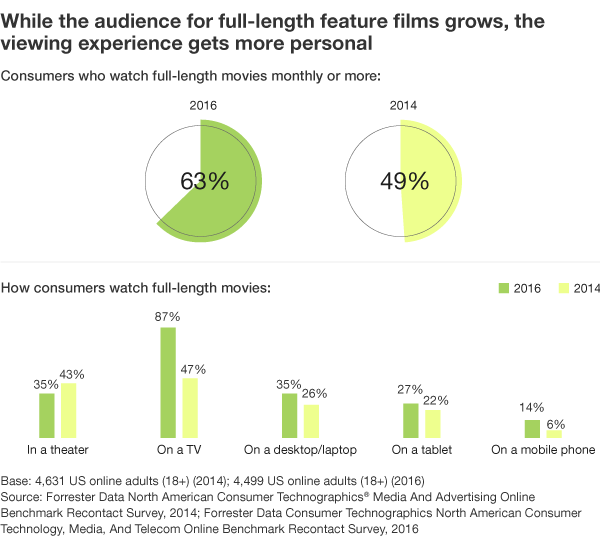The Data Digest: Cinema’s Lesson To Marketers
I love watching the annual Academy Awards — not only for the fashion show and blunders exposed on live TV but also to learn about how content resonates with audiences today and how cinema is evolving. In a world where people frequently face information overload and crave smaller bites (and bytes) of content, I’ve often wondered, what is the fate of the full-length film?
Forrester’s Consumer Technographics® data reveals a curious story: Rather than reaching any type of saturation point, US consumers’ media appetite is growing rapidly: 93% of online adults frequently watch video today, more than 10 percentage points higher than two years ago. And their often-criticized waning attention span is not deterring consumers from sitting through full-length films; in fact, movie viewership is on the rise. However, our data shows that the viewing experience is changing: Movie watching is getting more personal as consumers increasingly turn to their home devices instead of going to the movie theater.

This data shows that consumers’ capacity for longer-form content is alive and well — as long as the experience feels personal and convenient. There is a lesson here for brands that are also experimenting with video to captivate and move audiences: Stories come in various shapes and sizes — YouTube is eliminating its 30-second ads and focusing on 6-second videos, while Tiffany & Co. is launching an entire video series about art in the digital age — but content length is irrelevant when the story hooks the viewer and strikes a deeply personal, emotional chord.
In many ways, marketers already think like filmmakers. Certain ads aired during this year’s Oscars show the convergence of marketing and cinema quite literally: Rolex flashed its brand across historic film clips; Stella Artois tapped Matt Damon to deliver a poignant message; and Walmart cast a receipt as the main character in its own short films. But according to a recent report by my colleague Ryan Skinner, “digital content has flipped the script on marketers — from a strategy of memorable jingles to one of valuable content. In the post-digital era, marketers must entice their customers to want to look at their content at a moment that’s relevant to customers.” Marketers who think beyond catchy clips or sticky slogans and design compelling video content to draw viewers into a powerful story will deliver an emotional benefit, reach viewers on their most accessible devices, and have the greatest chance to win consumers’ hearts and minds.
